RxJS.Observable
- Package
- purescript-rxjs
- Repository
- jasonzoladz/purescript-rxjs
#Observable Source
data Observable :: Type -> TypeNote: A couple operators are not wrapped (namely, bindCallback, bindNodeCallback) because RxJS
implementation details prevent giving the operators an "honest" PureScript type.
However, such operators are replaced easily using Aff with the AsyncSubject module.
Please see RxJS Version 5.* documentation for
additional details on proper usage of the library.
Instances
Monoid (Observable a)Functor ObservableApply ObservableApplicative ObservableBind ObservableMonad ObservableSemigroup (Observable a)Alt ObservablePlus ObservableAlternative ObservableMonadZero ObservableMonadPlus ObservableMonadError Error ObservableMonadThrow Error Observable(Arbitrary a) => Arbitrary (Observable a)
#observeOn Source
observeOn :: forall a. Scheduler -> Observable a -> Observable aMakes every next call run in the new Scheduler.
#subscribeOn Source
subscribeOn :: forall a. Scheduler -> Observable a -> Observable aMakes subscription happen on a given Scheduler.
#subscribe Source
subscribe :: forall e a. Subscriber a -> Observable a -> Eff e SubscriptionSubscribing to an Observable is like calling a function, providing
next, error and completed effects to which the data will be delivered.
#subscribeNext Source
subscribeNext :: forall e a. (a -> Eff e Unit) -> Observable a -> Eff e Subscription#ajaxWithBody Source
ajaxWithBody :: forall e. Request -> Eff e (Observable Response)#fromArray Source
fromArray :: forall a. Array a -> Observable aCreates an Observable from an Array.
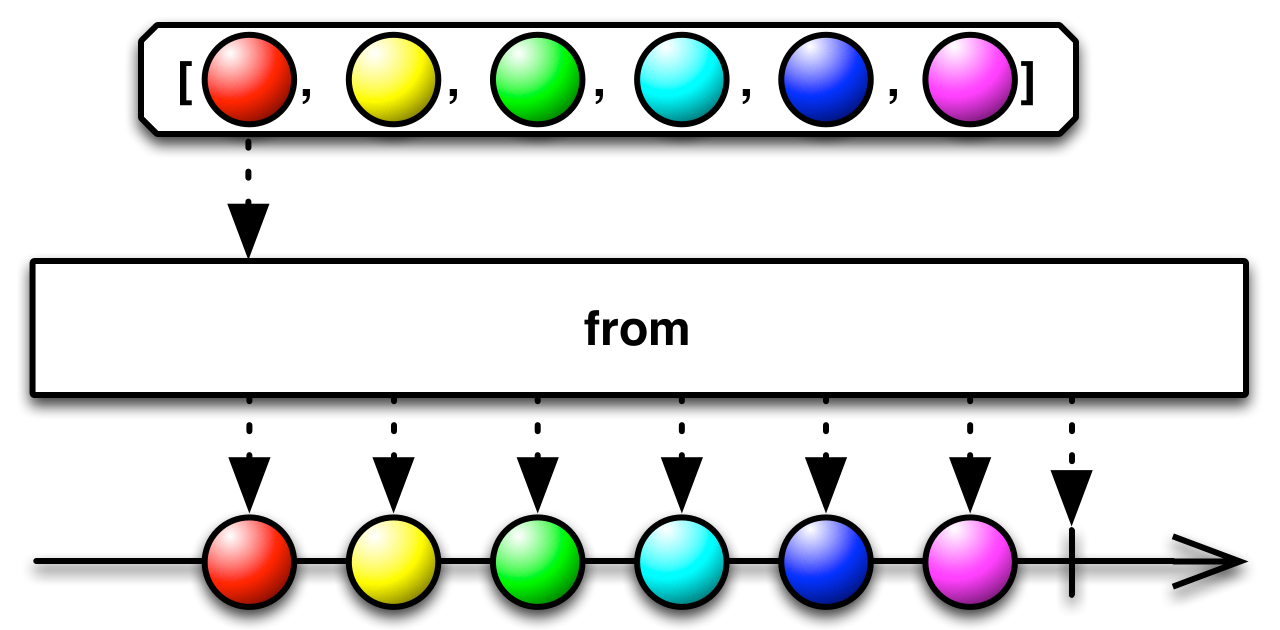
#fromEvent Source
fromEvent :: forall e. EventTarget -> EventType -> Eff e (Observable Event)Creates an Observable that emits events of the specified type coming from the given event target.
#interval Source
interval :: Int -> Observable IntReturns an Observable that emits an infinite sequence of ascending
integers, with a constant interval of time of your choosing between those
emissions.

#just Source
just :: forall a. a -> Observable aCreates an Observable that emits the value specify,
and then emits a complete notification. An alias for of.

#never Source
never :: forall a. Observable aCreates an Observable that emits no items. Subscriptions it must be
disposed manually.

#range Source
range :: Int -> Int -> Observable IntThe range operator emits a range of sequential integers, in order, where you select the start of the range and its length 
#buffer Source
buffer :: forall b a. Observable a -> Observable b -> Observable (Array a)Collects values from the first Observable into an Array, and emits that array only when
second Observable emits.

#bufferCount Source
bufferCount :: forall a. Int -> Int -> Observable a -> Observable (Array a)Collects values from the past as an array, emits that array when
its size (arg1) reaches the specified buffer size, and starts a new buffer.
The new buffer starts with nth (arg2) element of the Observable counting
from the beginning of the last buffer.

#bufferToggle Source
bufferToggle :: forall c b a. (Observable a) -> (Observable b) -> (b -> Observable c) -> (Observable (Array a))Collects values from the source Observable (arg1) as an array. Starts collecting only when
the opening (arg2) Observable emits, and calls the closingSelector function (arg3) to get an Observable
that decides when to close the buffer. Another buffer opens when the
opening Observable emits its next value.

#bufferWhen Source
bufferWhen :: forall b a. Observable a -> (a -> Observable b) -> Observable (Array a)Collects values from the past as an array. When it starts collecting values,
it calls a function that returns an Observable that emits to close the
buffer and restart collecting.

#concatMap Source
concatMap :: forall b a. Observable a -> (a -> Observable b) -> Observable bEquivalent to mergeMap (a.k.a, >>=) EXCEPT that, unlike mergeMap,
the next bind will not run until the Observable generated by the projection function (arg2)
completes. That is, composition is sequential, not concurrent.
Warning: if source values arrive endlessly and faster than their corresponding
inner Observables can complete, it will result in memory issues as inner
Observables amass in an unbounded buffer waiting for their turn to be subscribed to.
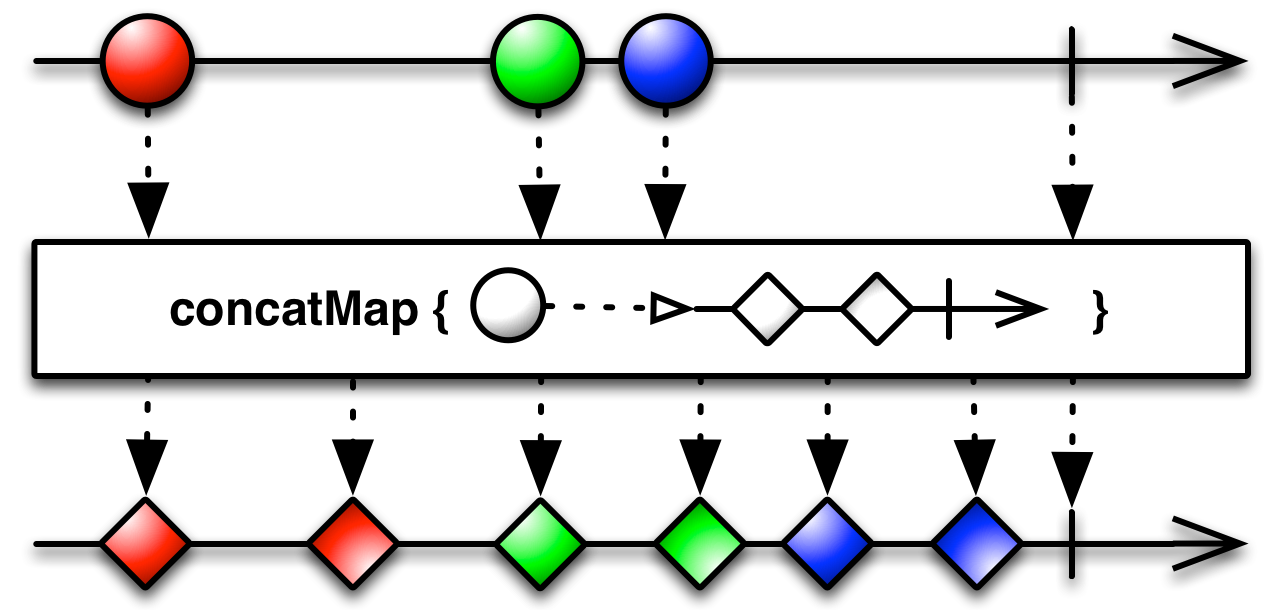
#concatMapTo Source
concatMapTo :: forall c b a. Observable a -> Observable b -> (a -> b -> Observable c) -> Observable cThe type signature explains it best. Warning: Like concatMap, composition is sequential.

#exhaustMap Source
exhaustMap :: forall b a. Observable a -> (a -> Observable b) -> Observable bIt's Like concatMap (a.k.a, >>=) EXCEPT that it ignores every new projected
Observable if the previous projected Observable has not yet completed.

#expand Source
expand :: forall a. Observable a -> (a -> Observable a) -> Observable aIt's similar to mergeMap, but applies the projection function to every source value as well as every output value. It's recursive.
#groupBy Source
groupBy :: forall b a. (a -> b) -> Observable a -> Observable (Observable a)Groups the items emitted by an Observable (arg2) according to the value
returned by the grouping function (arg1). Each group becomes its own
Observable.
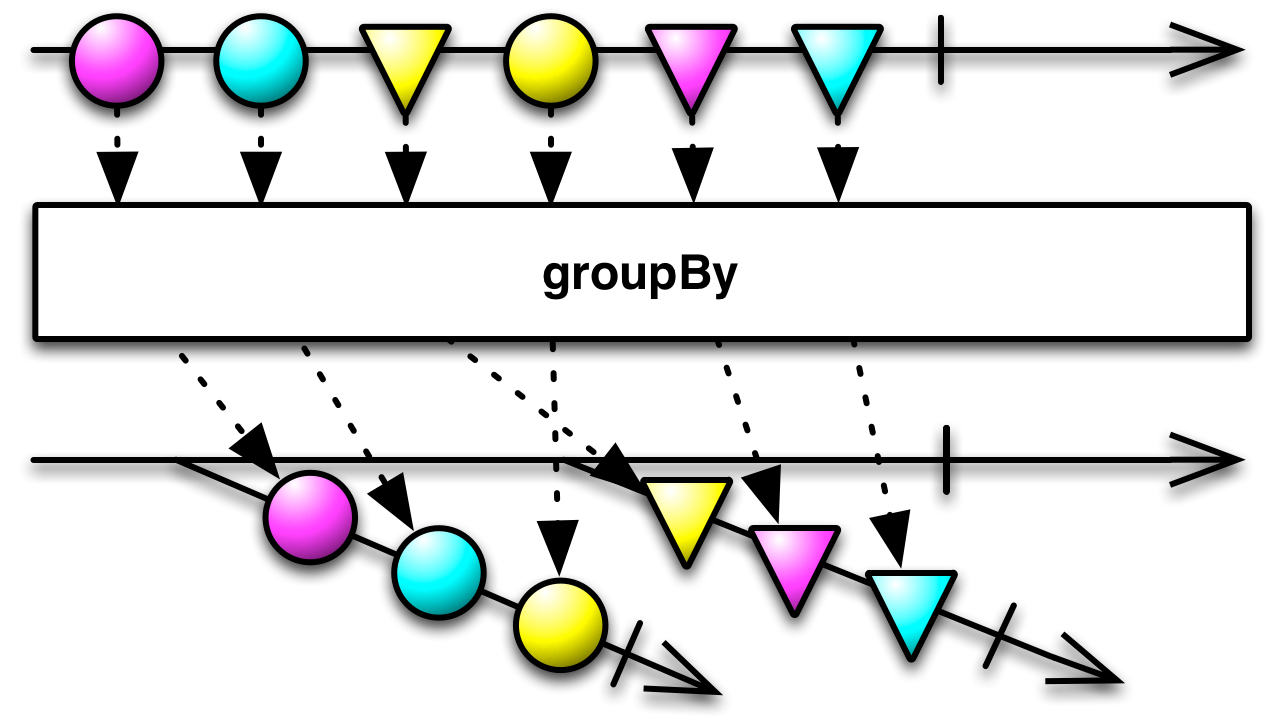
#mapTo Source
mapTo :: forall b a. b -> Observable a -> Observable bEmits the given constant value on the output Observable every time
the source Observable emits a value.

#mergeMap Source
mergeMap :: forall b a. Observable a -> (a -> Observable b) -> Observable bMaps each value to an Observable, then flattens all of these Observables
using mergeAll. It's just monadic bind.

#mergeMapTo Source
mergeMapTo :: forall b a. Observable a -> Observable b -> Observable bMaps each value of the Observable (arg1) to the same inner Observable (arg2),
then flattens the result.

#pairwise Source
pairwise :: forall a. Observable a -> Observable (Array a)Puts the current value and previous value together as an array, and emits that.

#partition Source
partition :: forall a. (a -> Boolean) -> Observable a -> Array (Observable a)Given a predicate function (arg1), and an Observable (arg2), it outputs a
two element array of partitioned values
(i.e., [ Observable valuesThatPassPredicate, Observable valuesThatFailPredicate ]).

#scan Source
scan :: forall b a. (a -> b -> b) -> b -> Observable a -> Observable bGiven an accumulator function (arg1), an initial value (arg2), and
a source Observable (arg3), it returns an Observable that emits the current
accumlation whenever the source emits a value.
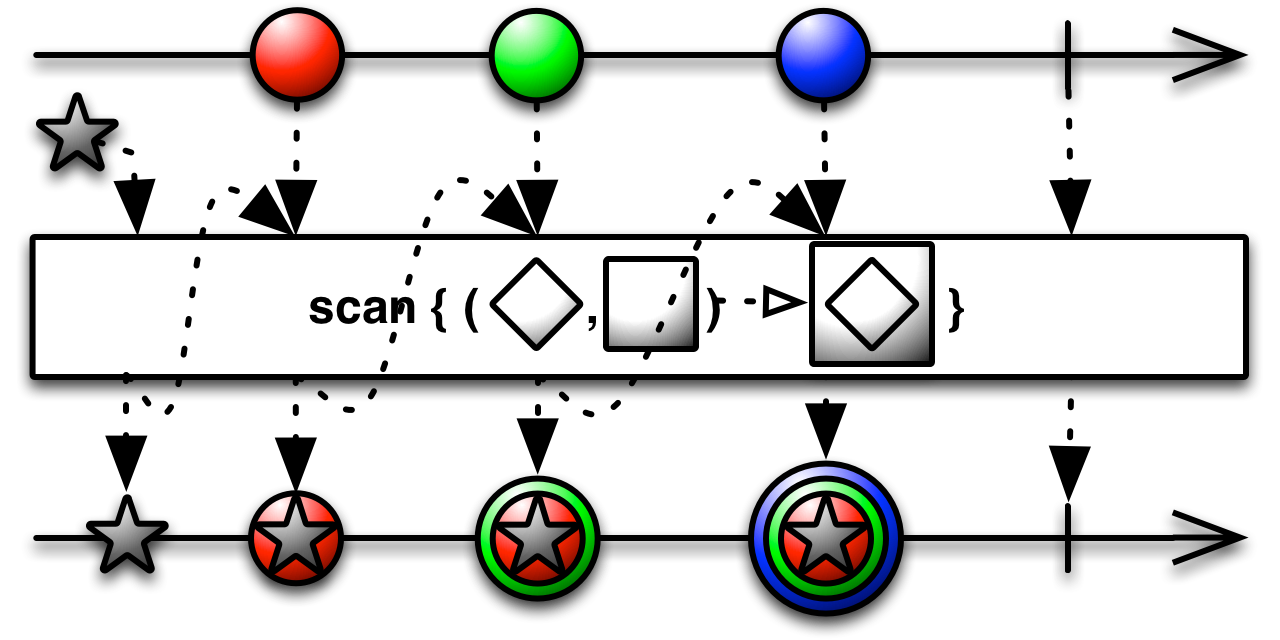
#switchMap Source
switchMap :: forall b a. Observable a -> (a -> Observable b) -> Observable bProjects each source value to an Observable which is merged in the output
Observable, emitting values only from the most recently projected Observable.
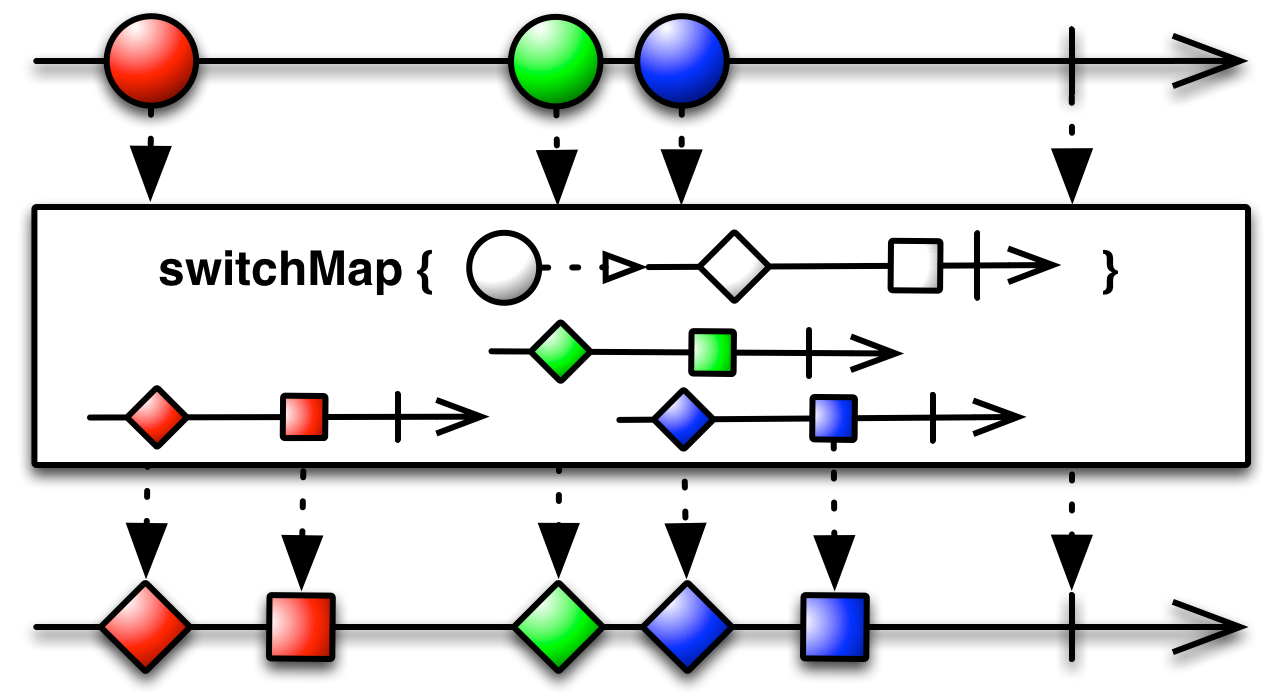
#switchMapTo Source
switchMapTo :: forall b a. Observable a -> Observable b -> Observable bIt's like switchMap, but maps each value to the same inner Observable.

#window Source
window :: forall b a. Observable a -> Observable b -> Observable (Observable a)It's like buffer, but emits a nested Observable instead of an array.
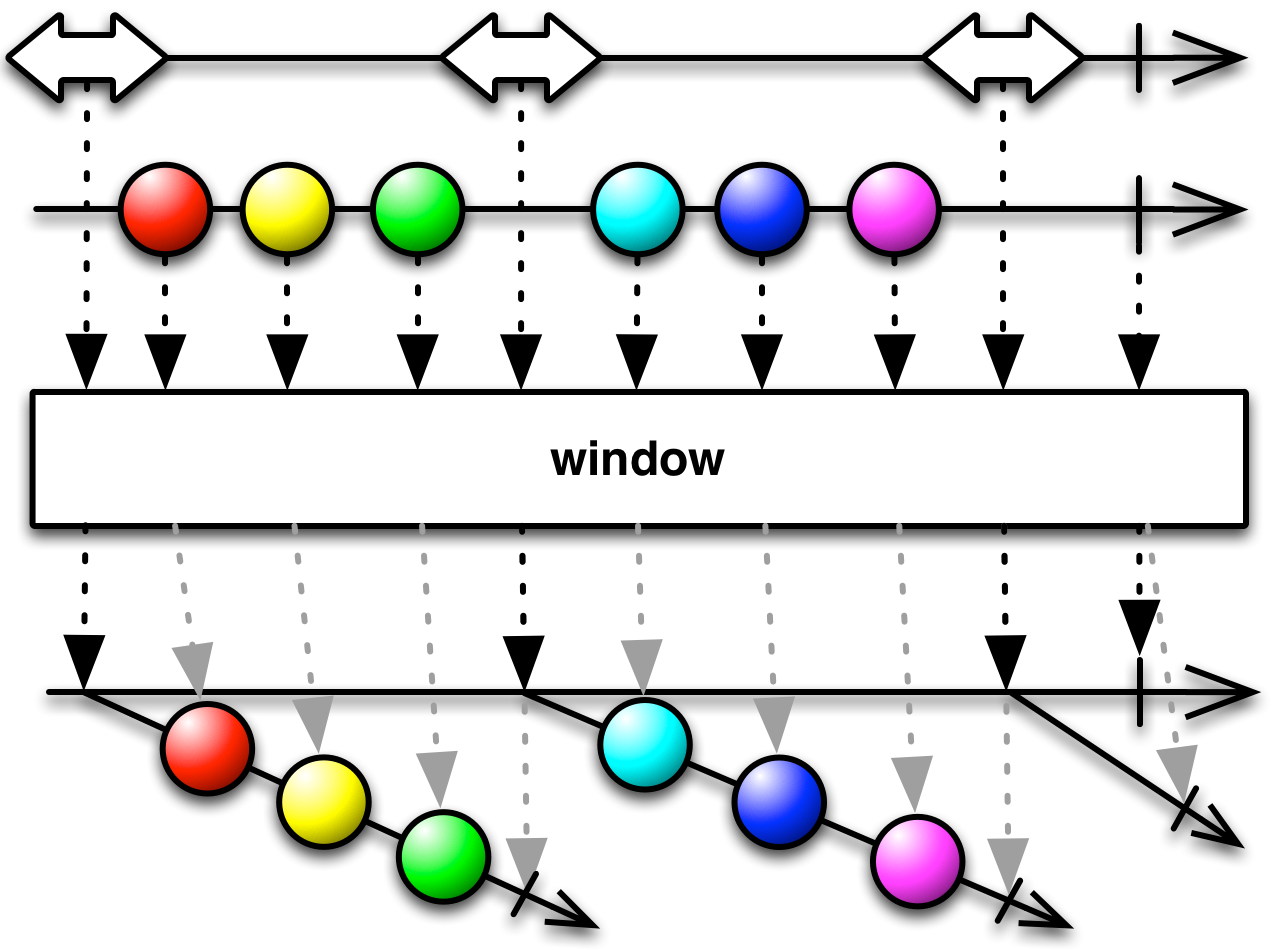
#windowCount Source
windowCount :: forall a. Int -> Int -> Observable a -> Observable (Observable a)It's like bufferCount, but emits a nested Observable instead of an array.
#windowTime Source
windowTime :: forall a. Int -> Int -> Observable a -> Observable (Observable a)It's like bufferTime, but emits a nested Observable instead of an array, and it doesn't take a maximum size parameter. arg1 is how long to buffer items into a new Observable, arg2 is the when the next buffer should begin, and arg3 is the source Observable.
#windowToggle Source
windowToggle :: forall c b a. (Observable a) -> (Observable b) -> (b -> Observable c) -> (Observable (Array a))It's like bufferToggle, but emits a nested Observable instead of an array.
#windowWhen Source
windowWhen :: forall b a. Observable a -> Observable b -> Observable (Observable a)It's like bufferWhen, but emits a nested Observable instead of an array.
#audit Source
audit :: forall b a. Observable a -> (a -> Observable b) -> Observable aIt's like auditTime, but the silencing duration is determined by a second Observable.

#auditTime Source
auditTime :: forall a. Int -> Observable a -> Observable aIgnores source values for duration milliseconds,
then emits the most recent value from the source Observable, then repeats this process.

#debounce Source
debounce :: forall a. Observable a -> (a -> Observable Int) -> Observable aIt's like debounceTime, but the time span of emission silence is determined
by a second Observable. Allows for a variable debounce rate.
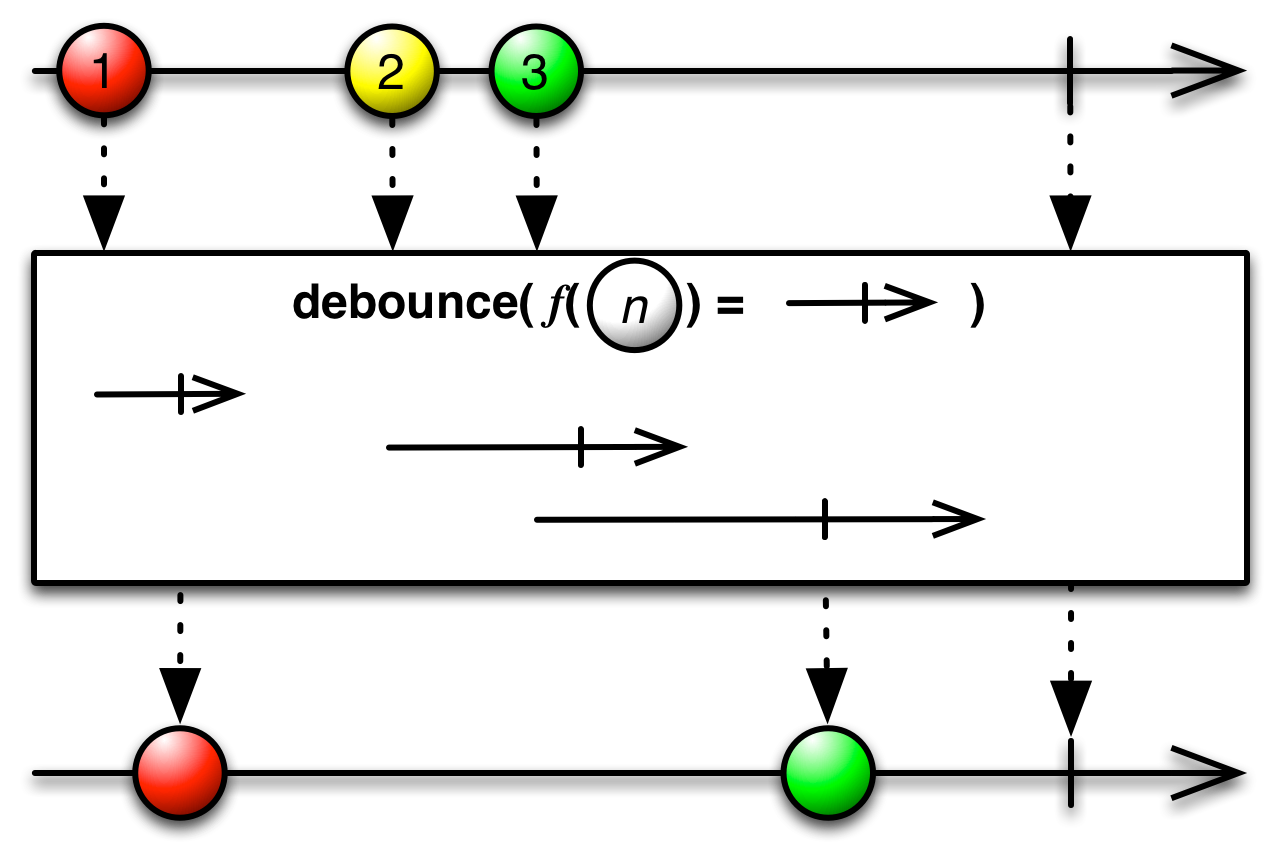
#debounceTime Source
debounceTime :: forall a. Int -> Observable a -> Observable aIt's like delay, but passes only the most recent value from each burst of emissions.
#distinct Source
distinct :: forall a. Observable a -> Observable aReturns an Observable that emits all items emitted by the source Observable
that are distinct by comparison from previous items.

#distinctUntilChanged Source
distinctUntilChanged :: forall a. Observable a -> Observable aReturns an Observable that emits all items emitted by the source Observable
that are distinct by comparison from the previous item.
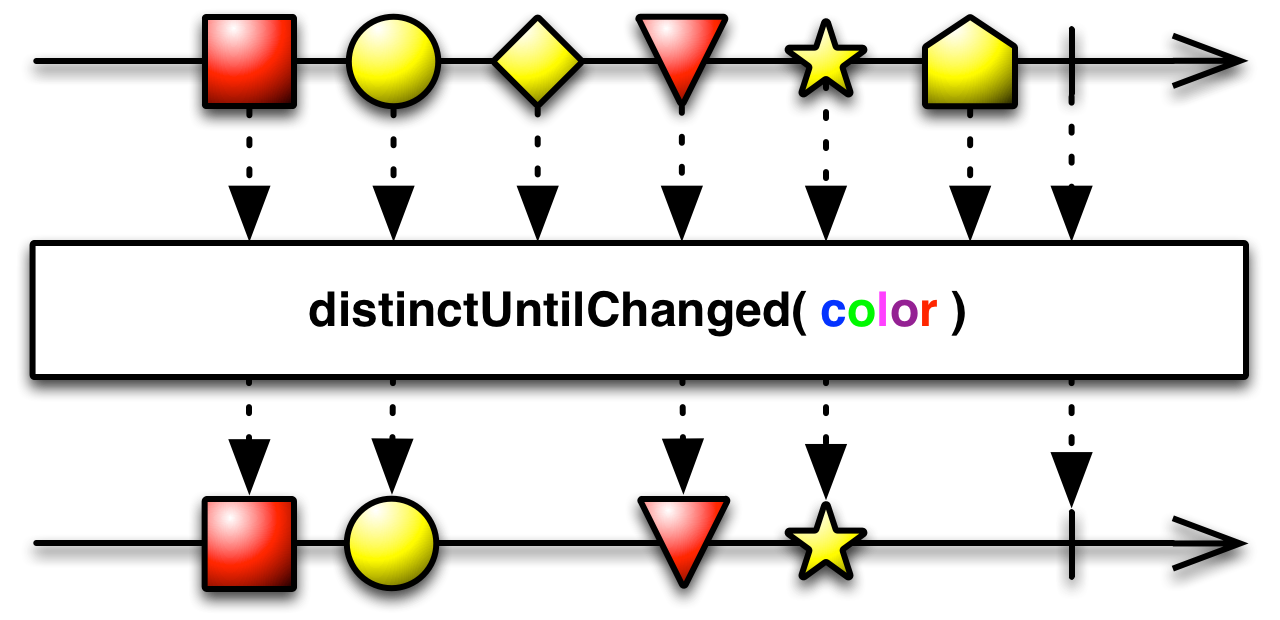
#elementAt Source
elementAt :: forall a. Observable a -> Int -> Observable aEmits the single value at the specified index in a sequence of emissions from the source Observable.
#filter Source
filter :: forall a. (a -> Boolean) -> Observable a -> Observable aFilter items emitted by the source Observable by only emitting those that
satisfy a specified predicate.

#ignoreElements Source
ignoreElements :: forall a. Observable a -> Observable aIgnores all items emitted by the source Observable and only passes calls of complete or error.

#last Source
last :: forall a. Observable a -> (a -> Boolean) -> Observable aReturns an Observable that emits only the last item emitted by the source
Observable that that satisfies the given predicate.
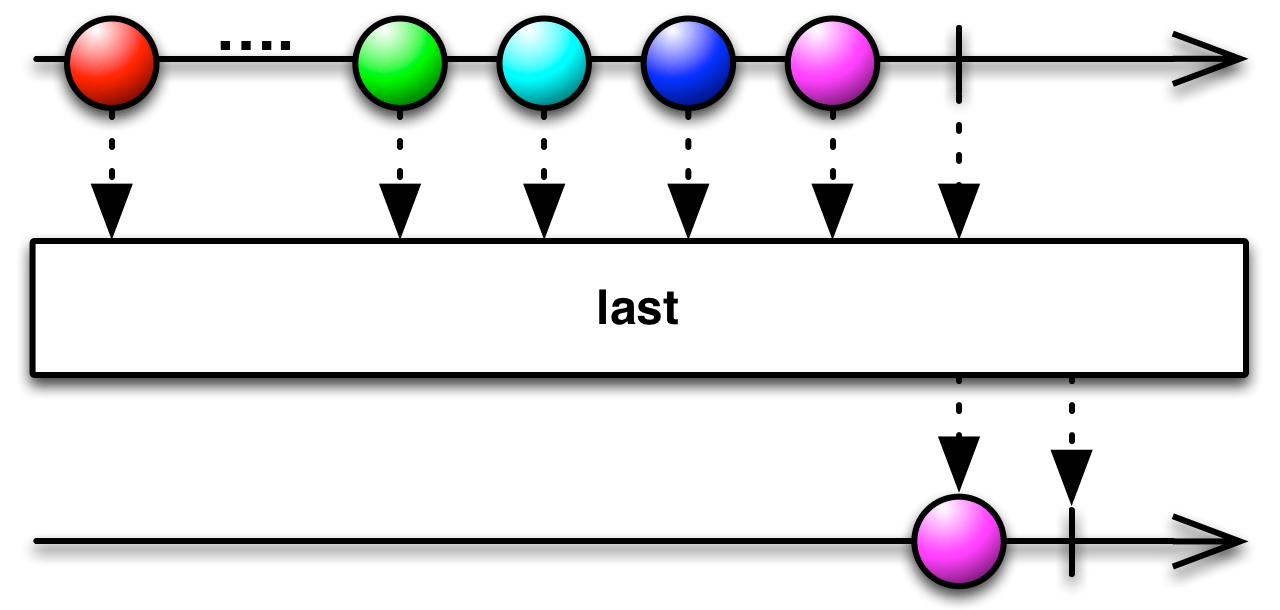
#sample Source
sample :: forall b a. Observable a -> Observable b -> Observable aIt's like sampleTime, but samples whenever the notifier Observable emits something.
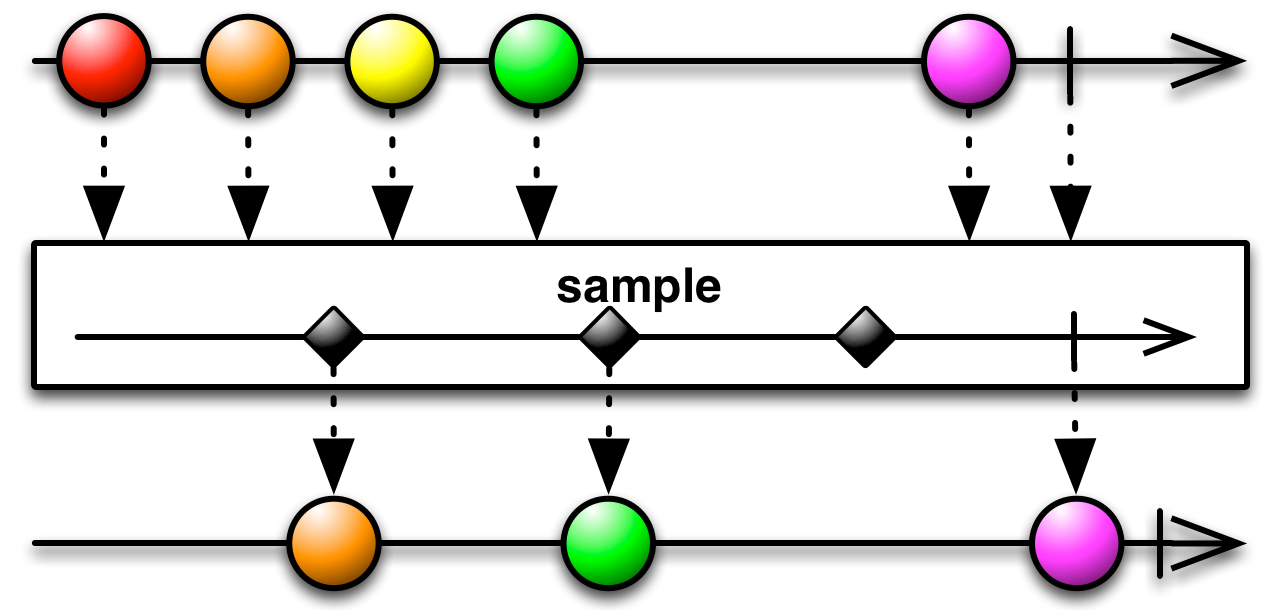
#sampleTime Source
sampleTime :: forall a. Int -> Observable a -> Observable aPeriodically looks at the source Observable and emits whichever value it has most recently emitted since the previous sampling, unless the source has not emitted anything since the previous sampling.
#skip Source
skip :: forall a. Int -> Observable a -> Observable aReturns an Observable that skips n items emitted by an Observable.
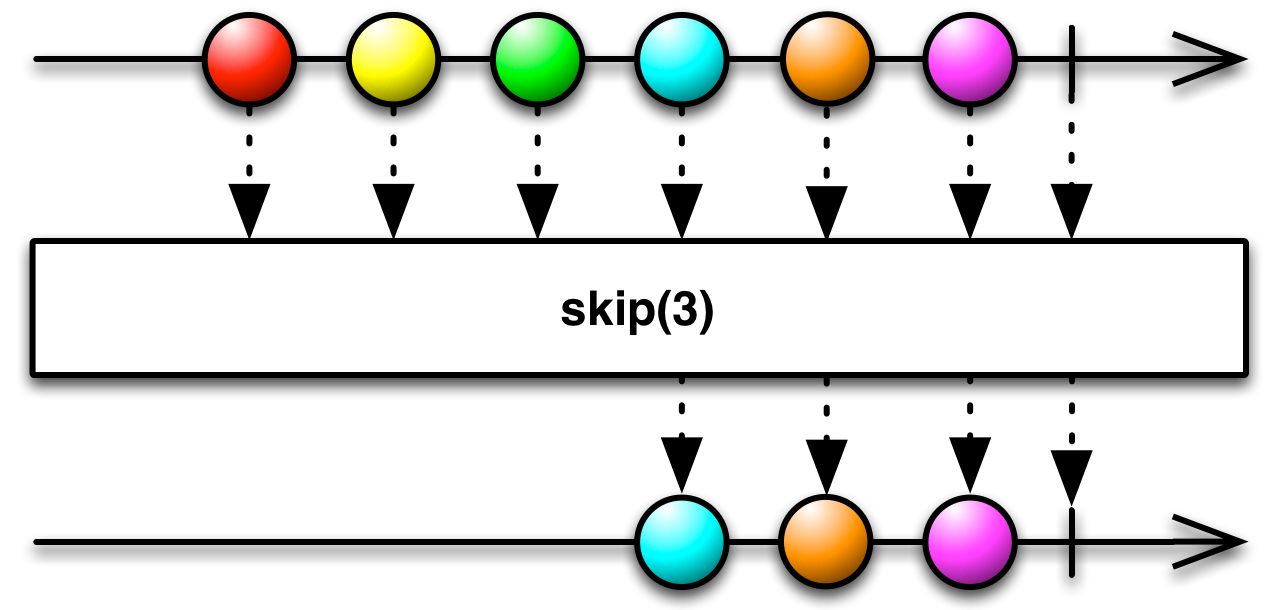
#skipUntil Source
skipUntil :: forall b a. Observable a -> Observable b -> Observable aReturns an Observable that skips items emitted by the source Observable until a second Observable emits an item.
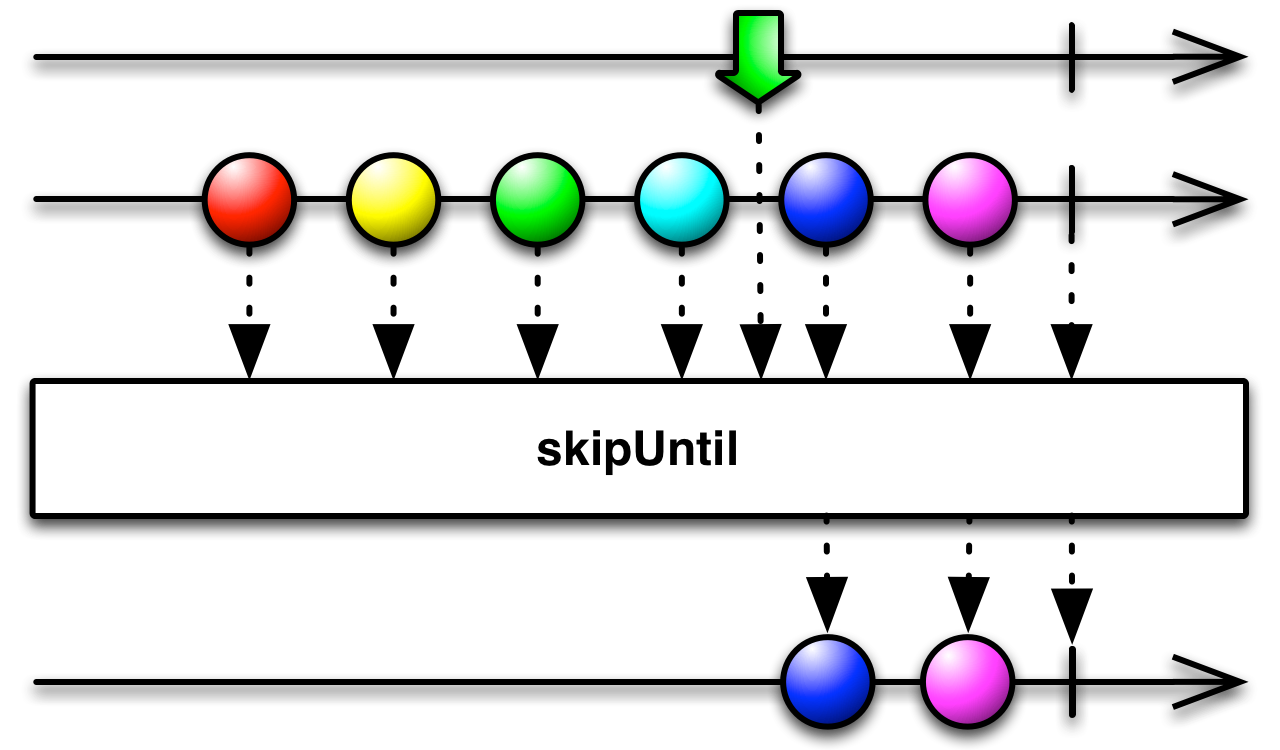
#skipWhile Source
skipWhile :: forall a. (a -> Boolean) -> Observable a -> Observable aReturns an Observable that skips all items emitted
by the source Observable as long as a specified condition holds true,
but emits all further source items as soon as the condition becomes false.
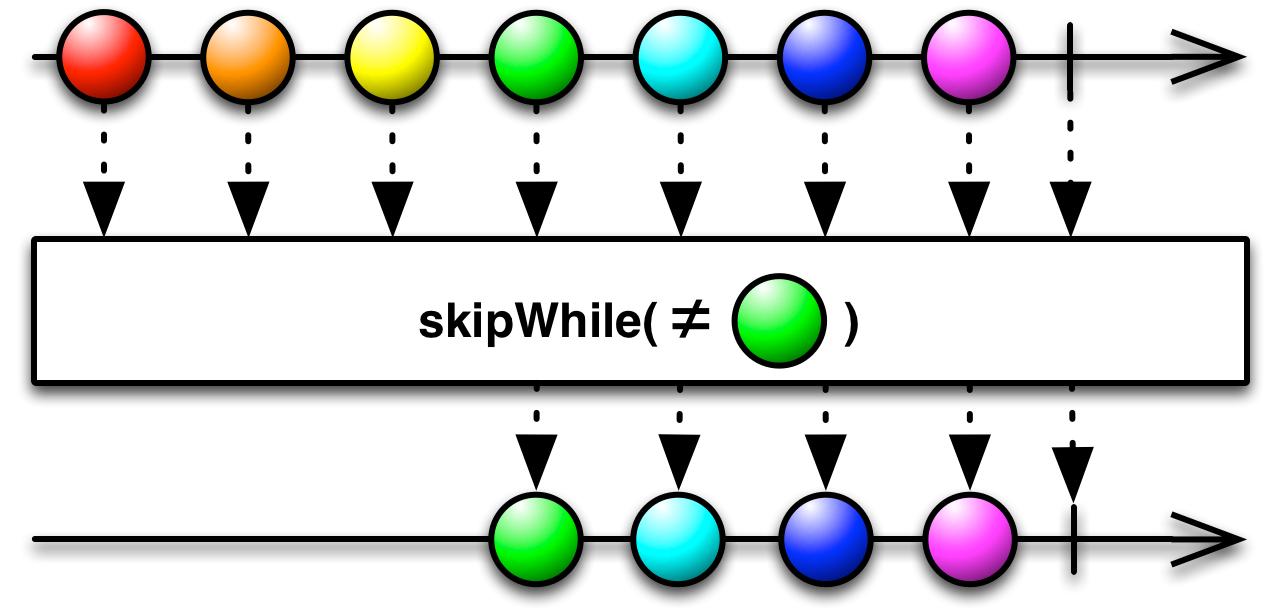
#take Source
take :: forall a. Int -> Observable a -> Observable aEmits only the first n values emitted by the source Observable.
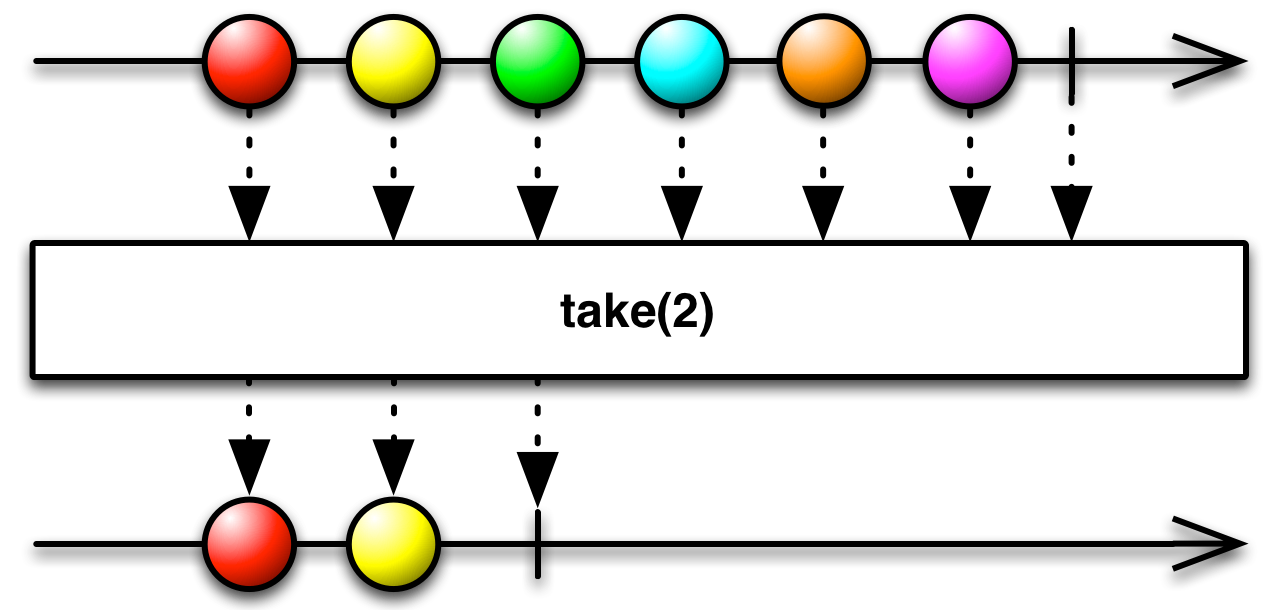
#takeUntil Source
takeUntil :: forall b a. Observable a -> Observable b -> Observable aLets values pass until a second Observable emits something. Then, it completes.  -> Observable a -> Observable aEmits values emitted by the source Observable so long as each value satisfies the given predicate, and then completes as soon as this predicate is not satisfied.
#throttle Source
throttle :: forall b a. Observable a -> (a -> Observable b) -> Observable aIt's like throttleTime, but the silencing duration is determined by a second Observable. 
#combineLatest Source
combineLatest :: forall c b a. (a -> b -> c) -> Observable a -> Observable b -> Observable cAn Observable of projected values from the most recent values from each input Observable.

#combineLatest3 Source
combineLatest3 :: forall d c b a. (a -> b -> c -> d) -> Observable a -> Observable b -> Observable c -> Observable d#concat Source
concat :: forall a. Observable a -> Observable a -> Observable aConcatenates two Observables together by sequentially emitting their values, one Observable after the other.
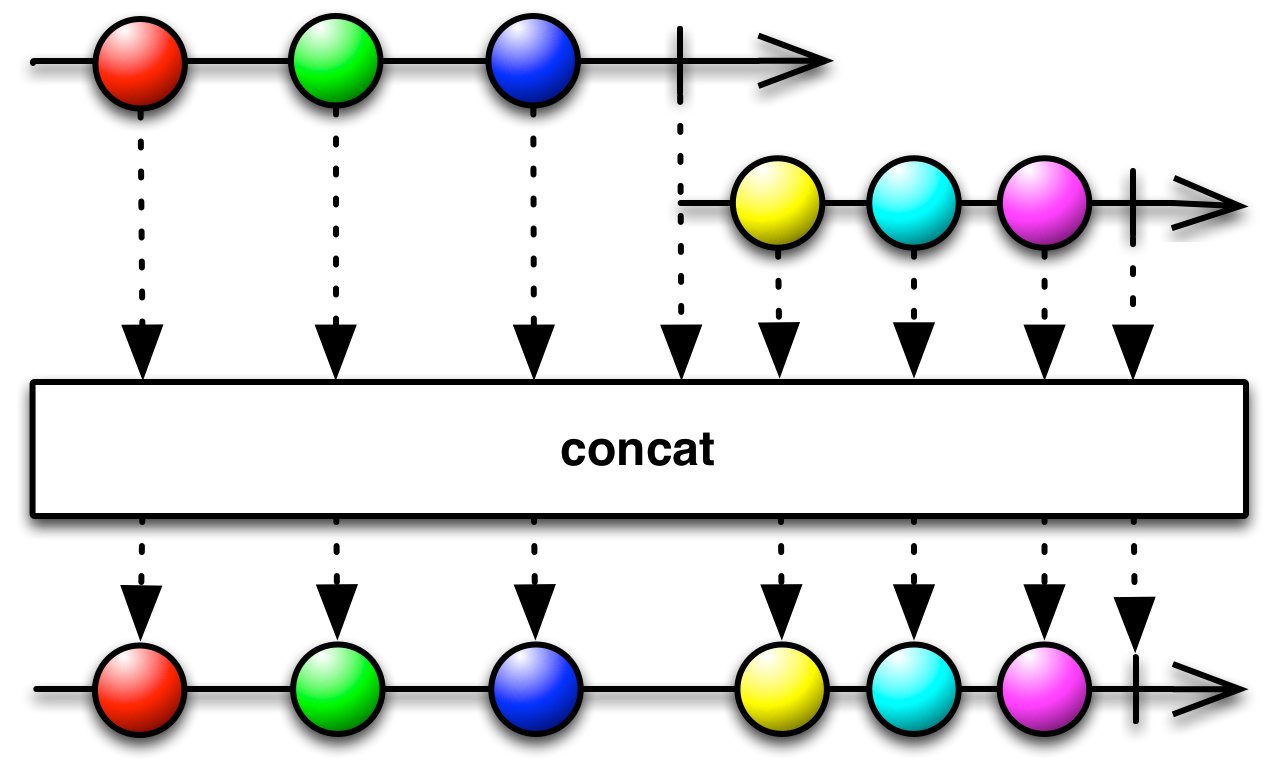
#concatAll Source
concatAll :: forall a. Observable (Observable a) -> Observable aConverts a higher-order Observable into a first-order Observable by concatenating the inner Observables in order.

#exhaust Source
exhaust :: forall a. Observable (Observable a) -> Observable aFlattens an Observable-of-Observables by dropping the next inner Observables
while the current inner is still executing.

#merge Source
merge :: forall a. Observable a -> Observable a -> Observable aCreates an output Observable which concurrently emits all values from each input Observable.
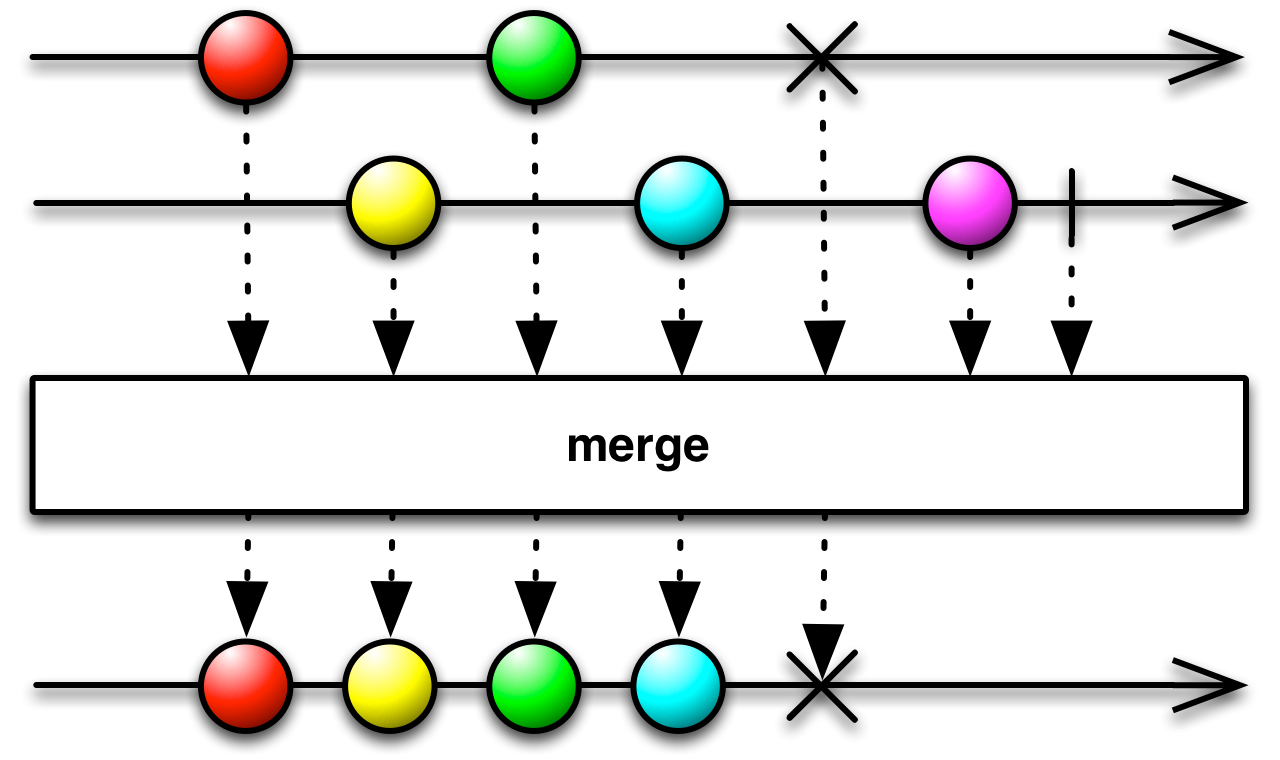
#mergeAll Source
mergeAll :: forall a. Observable (Observable a) -> Observable aConverts a higher-order Observable into a first-order Observable
which concurrently delivers all values that are emitted on the inner Observables.

#race Source
race :: forall a. Array (Observable a) -> Observable aReturns an Observable that mirrors the first source Observable to emit an item from the array of Observables.
#startWithMany Source
startWithMany :: forall a f. Foldable f => f a -> Observable a -> Observable aReturns an Observable that emits the items in the given Foldable before it begins to emit items emitted by the source Observable.
#startWith Source
startWith :: forall a. a -> Observable a -> Observable aReturns an Observable that emits the item given before
it begins to emit items emitted by the source Observable.
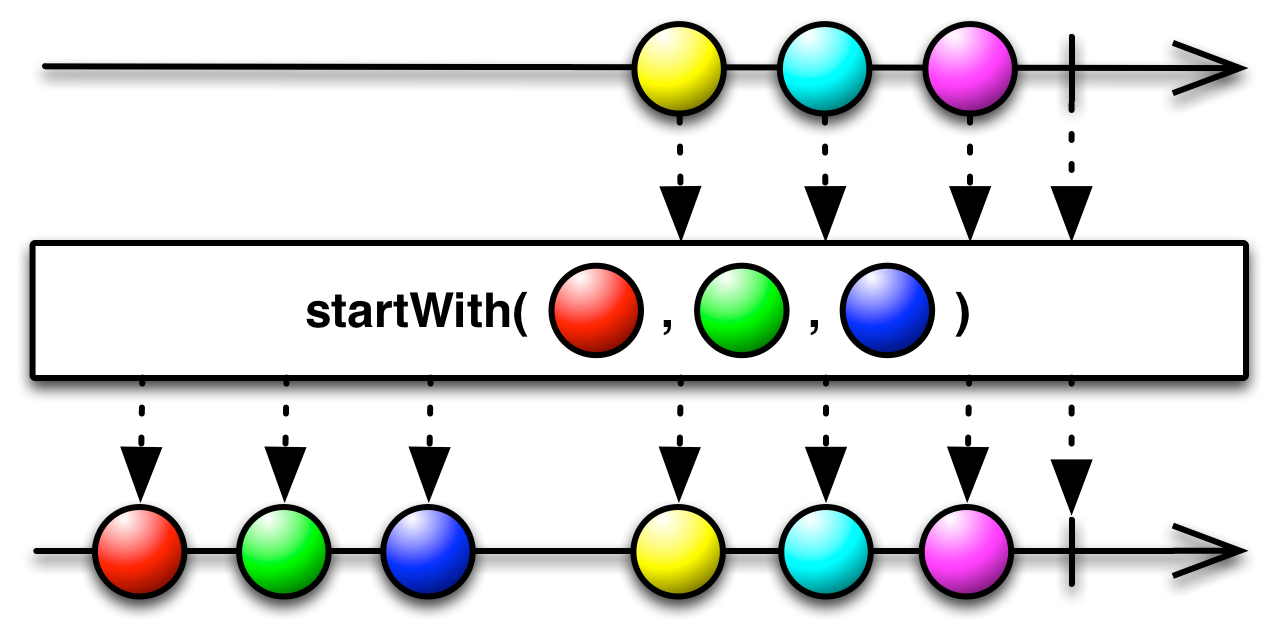
#withLatestFrom Source
withLatestFrom :: forall c b a. (a -> b -> c) -> Observable a -> Observable b -> Observable cCombines each value from the source Observables using a project function to determine the value to be emitted on the output Observable.  -> Observable (Array a)Waits for each Observable to emit a value. Once this occurs, all values
with the corresponding index will be emitted. This will continue until at
least one inner observable completes.
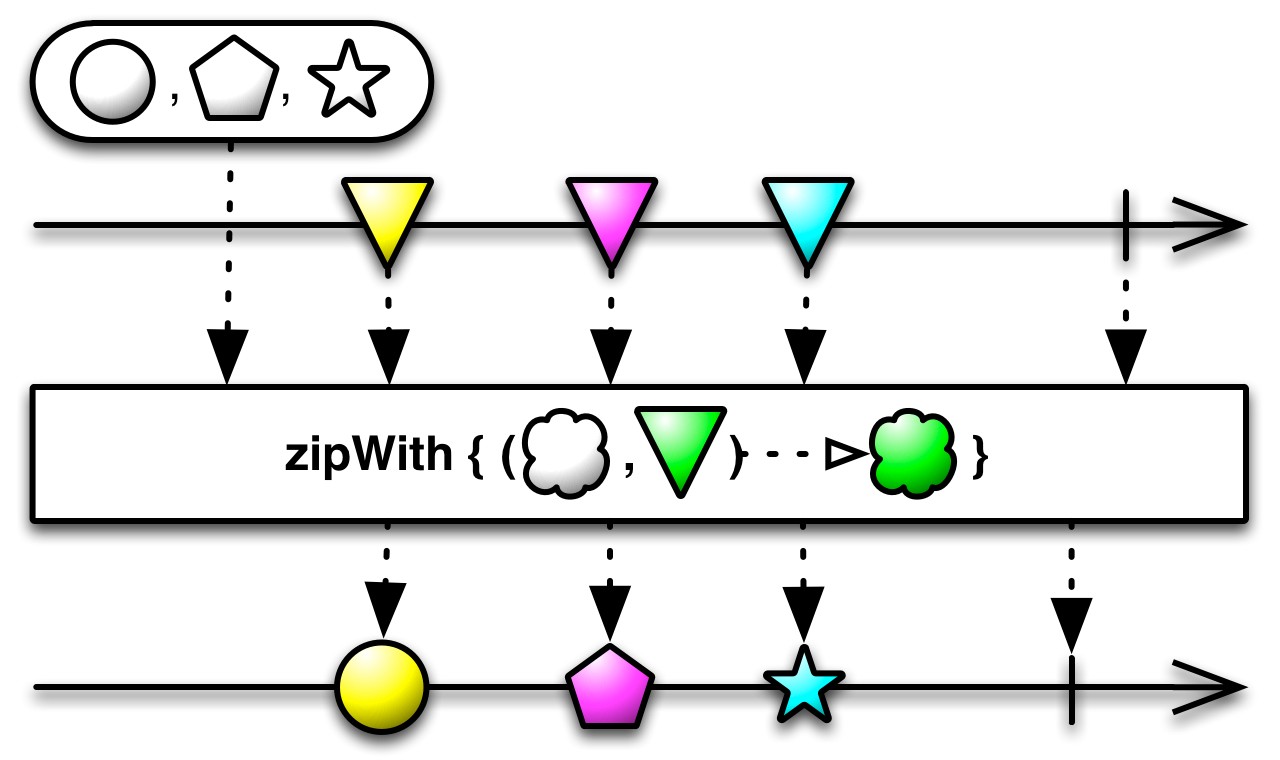
#catch Source
catch :: forall a. (Observable a) -> (Error -> Observable a) -> (Observable a)
#retry Source
retry :: forall a. Int -> Observable a -> Observable aIf the source Observable calls error, this method will resubscribe to the
source Observable n times rather than propagating the error call.
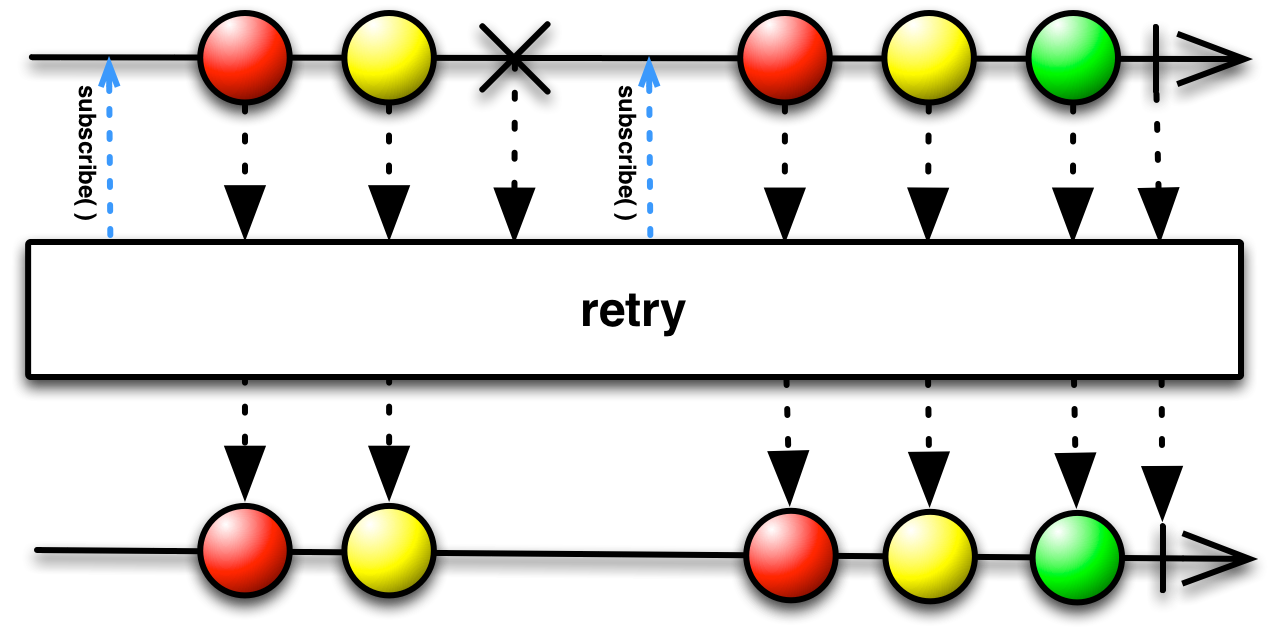
#delay Source
delay :: forall a. Int -> Observable a -> Observable aTime shifts each item by some specified amount of milliseconds.
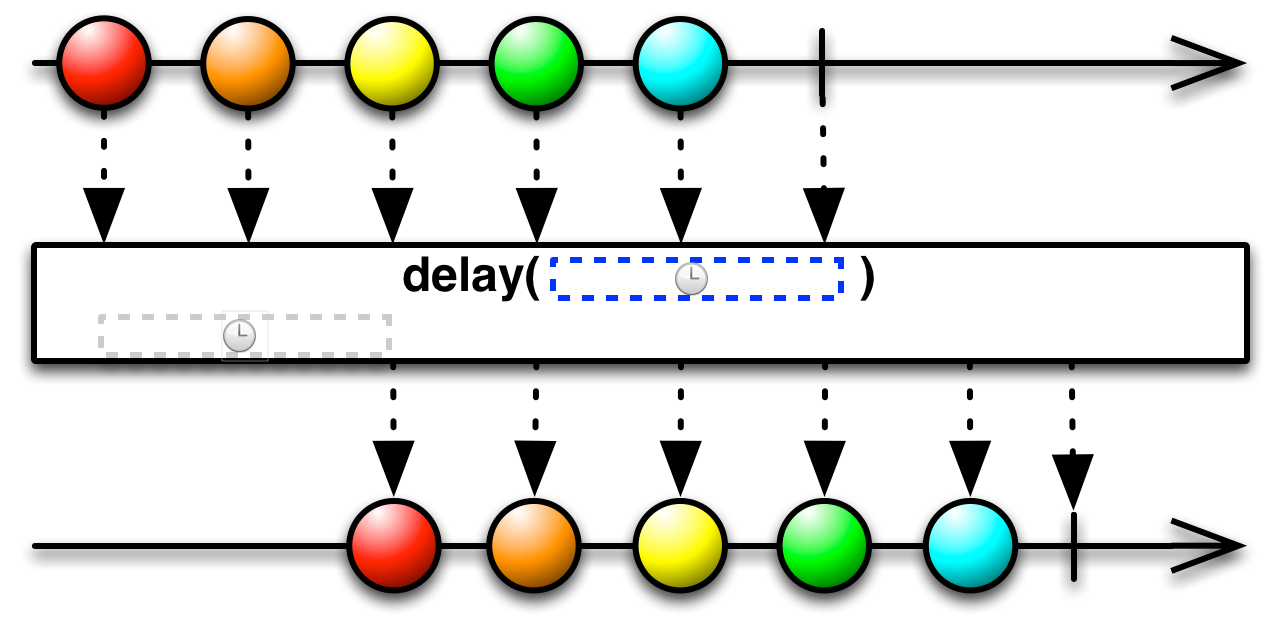
#delayWhen Source
delayWhen :: forall b a. Observable a -> (a -> Observable b) -> Observable aDelays the emission of items from the source Observable by a given time
span determined by the emissions of another Observable.
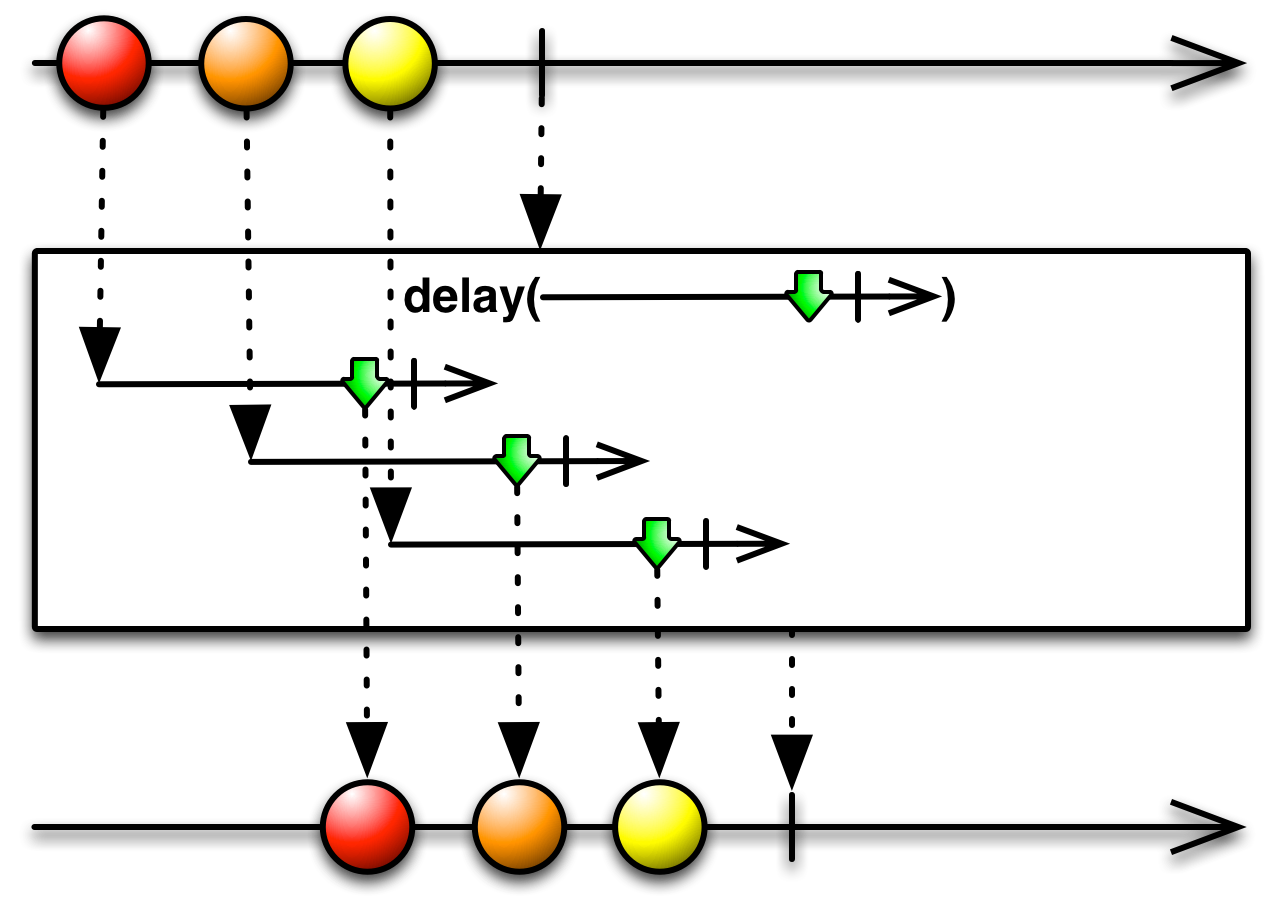
#dematerialize Source
dematerialize :: forall a. Observable (Notification a) -> Observable aReturns an Observable that reverses the effect of materialize by
Notification objects emitted by the source Observable into the items
or notifications they represent.
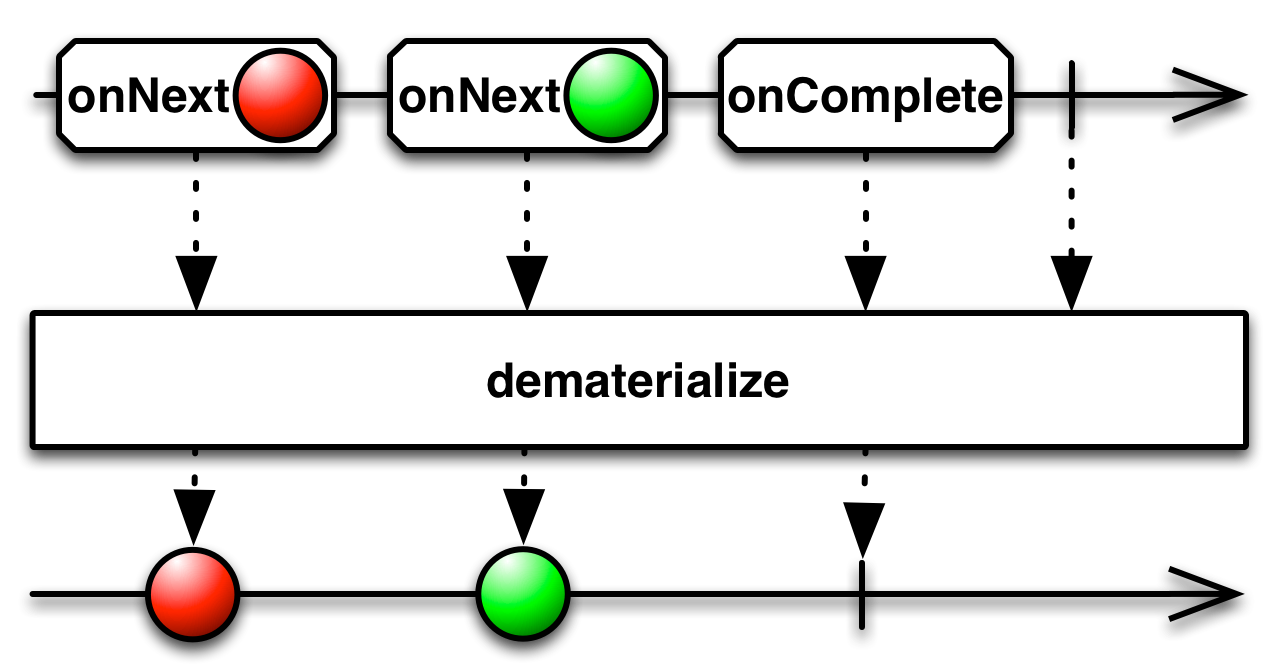
#materialize Source
materialize :: forall a. Observable a -> Observable (Notification a)Turns all of the notifications from a source Observable into onNext emissions,
and marks them with their original notification types within Notification objects.
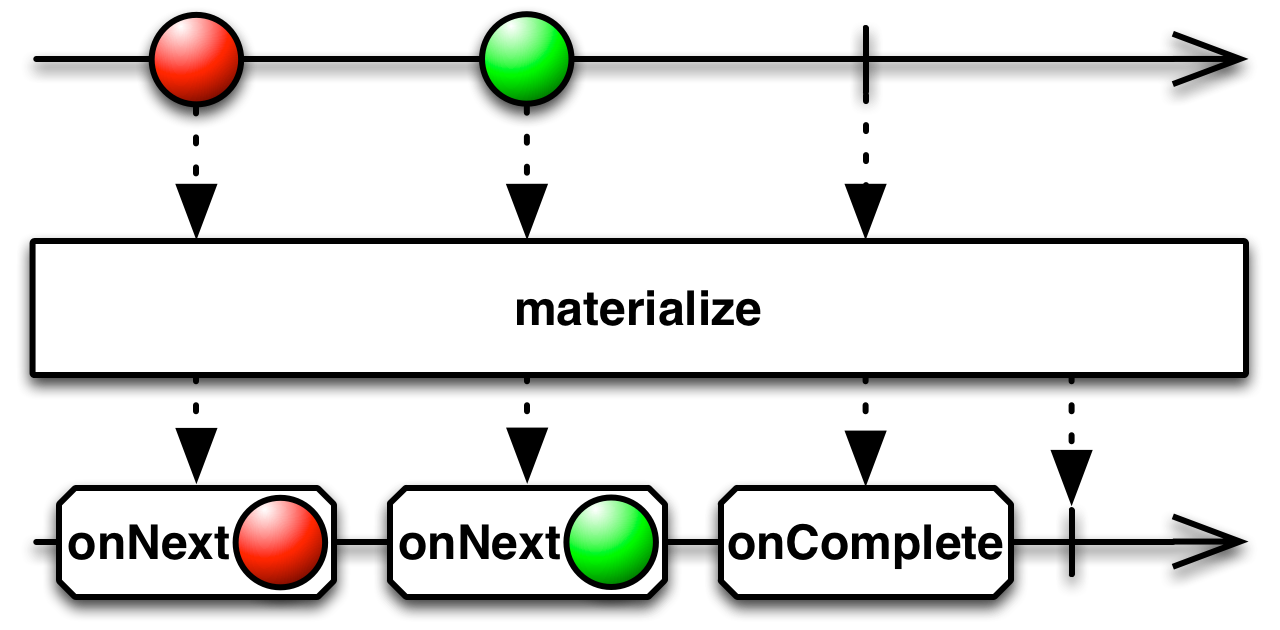
#performEach Source
performEach :: forall e a. Observable a -> (a -> Eff e Unit) -> Eff e (Observable a)Performs the effect on each value of the Observable. An alias for do.
Useful for testing (transparently performing an effect outside of a subscription).
#toArray Source
toArray :: forall a. Observable a -> Observable (Array a)Returns an Observable that emits a single item, a list composed of all the items emitted by the source Observable.
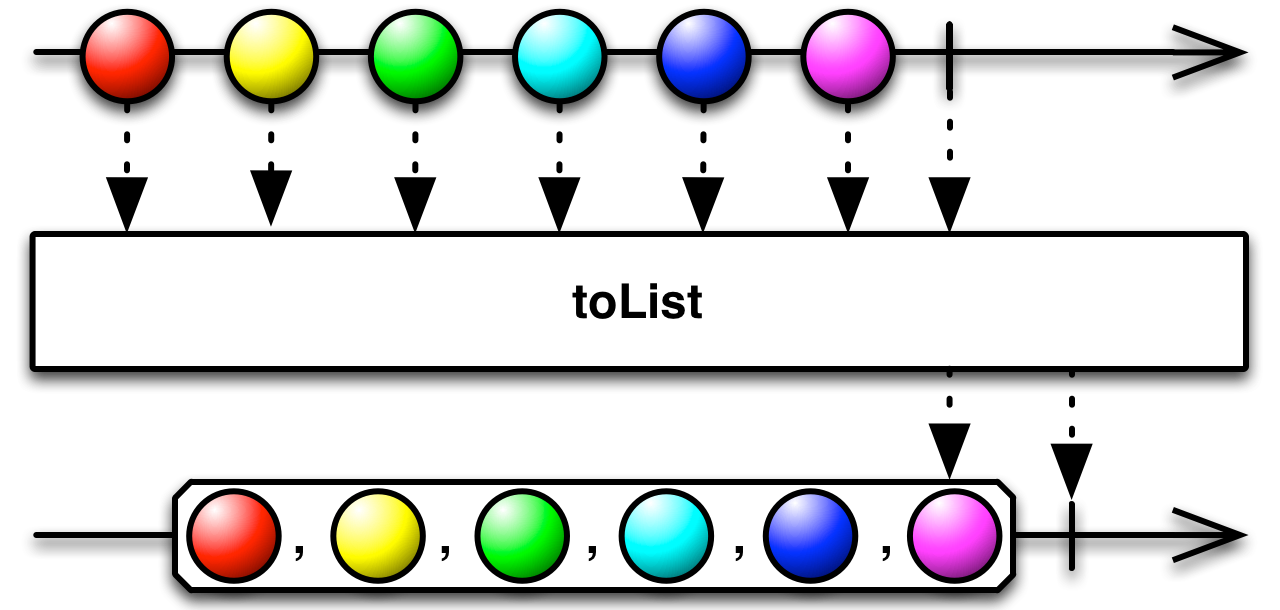
#defaultIfEmpty Source
defaultIfEmpty :: forall a. Observable a -> a -> Observable aReturns an Observable that emits the items emitted by the source Observable or a specified default item if the source Observable is empty.

takes a defaultValue which is the item to emit if the source Observable emits no items.
returns an Observable that emits either the specified default item if the source Observable emits no items, or the items emitted by the source Observable
#every Source
every :: forall a. Observable a -> (a -> Boolean) -> Observable BooleanDetermines whether all elements of an observable sequence satisfy a condition. Returns an observable sequence containing a single element determining whether all elements in the source sequence pass the test in the specified predicate.
#isEmpty Source
isEmpty :: forall a. Observable a -> Observable BooleanTests whether this Observable emits no elements.
returns an Observable emitting one single Boolean, which is true if this Observable
emits no elements, and false otherwise.
#first Source
first :: forall a. Observable a -> (a -> Boolean) -> Observable aReturns an Observable that emits only the first item emitted by the source Observable that satisfies the given predicate.
#count Source
count :: forall a. Observable a -> Observable IntCounts the number of emissions on the source and emits that number when the source completes.
#reduce Source
reduce :: forall b a. (a -> b -> b) -> b -> Observable a -> Observable bApplies an accumulator function over the source Observable, and returns the accumulated result when the source completes, given a seed value.
#unwrap Source
unwrap :: forall e a. Observable (Eff e a) -> Eff e (Observable a)Run an Observable of effects
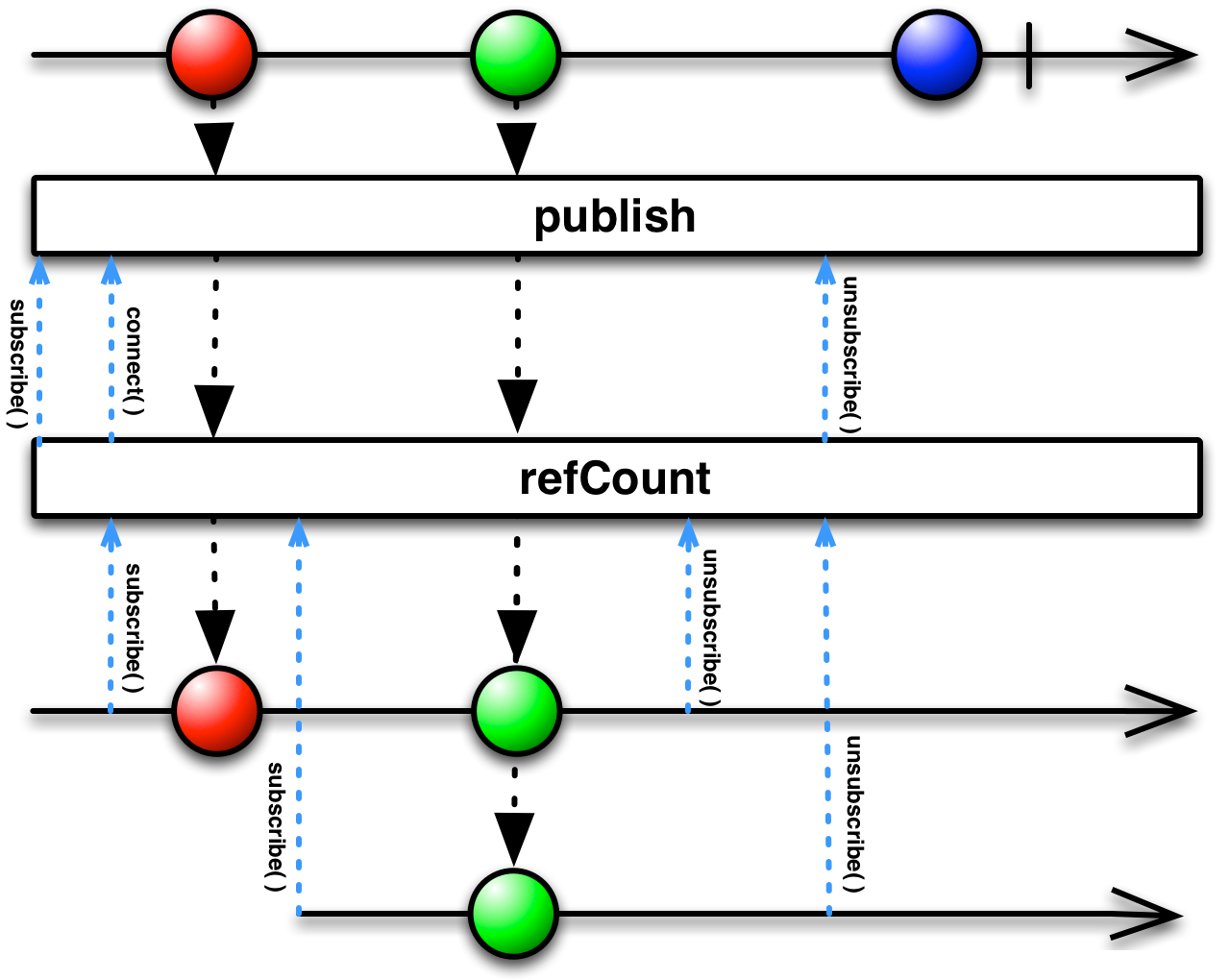
NOTE: The semigroup instance uses
mergeNOTconcat.